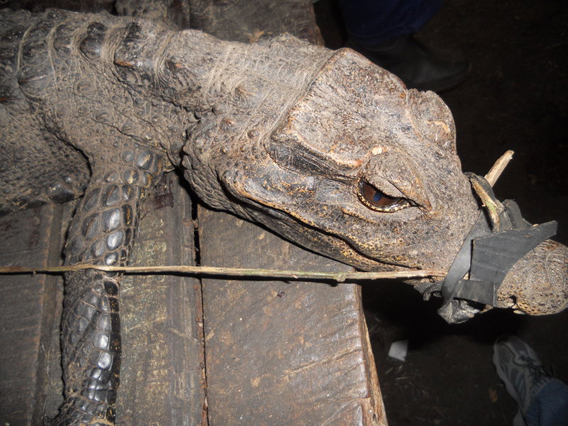
African slender-snouted crocodile caught by hunters. Photo courtesy of ESI.
Although founded only four years ago, Endangered Species International-Congo, has ambitious plans to protect dwindling Western gorilla populations and aid local people in the Republic of the Congo (Brazzaville). The organization, an offshoot of Endangered Species International (ESI), has been spending the last few years studying the bushmeat trade in Pointe-Noire, the country’s second largest city, and developing plans for turning hunters into conservationists.
“[We] conducted more than 140 surveys at the seven major markets in the city of Pointe-Noire, which represents around 1,000 bushmeat observations. A third of the observed species are protected under the Republic of the Congo,” Franck Makoundi, the project leader with ESI-Congo, told mongabay.com. Observers also counted seven instances of gorilla meat being sold.
Although Makoundi said, “This figure does not reflect the reality of the illegal trade because meat is also traded through other channels like direct sales to restaurants or individuals”
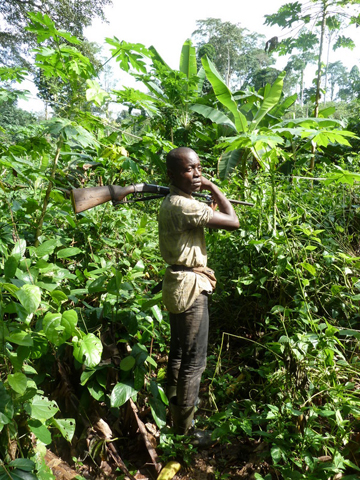 Hunter in the Republic of the Congo. Photo courtesy of ESI. |
The Republic of the Congo is home to the world’s largest populations of Western lowland gorilla (Gorilla gorilla gorilla), which is listed as Critically Endangered by the IUCN Red List. Hunting and the Ebola virus has decimated the species, cutting some populations down by as much as 90 percent in just the last 25 years. In addition many gorilla populations, even remote ones, have faced pressure on their forest habitats from new roads, hunting, logging, mining, and oil exploitation.
Good news, however, came in 2007 when the Wildlife Conservation Society (WCS) discovered unknown populations in the remote northern reaches of the Republic of the Congo, totaling around 125,000 individuals.
The ESI is targeting the bushmeat trade in the country’s south where a single gorilla hand can sell for less than $6.00. While monitoring wild gorilla populations, the group plans to work also with local communities to stop the bushmeat trade of gorillas and other protected species. Developing alternative incomes for locals is one way to mitigate poaching, according to Makoundi.
“Most hunters are in this trade to support their families. Thus, it is possible to offer them a support to develop other activities via the establishment of a cooperative.”
Few large conservation groups work on the ground in the Republic of the Congo (with the notable exception of the WCS) even though the country retains vast forests and stunning wildlife. In addition, to Western lowland gorillas, the country is home to chimpanzees, elephants, leopards, and mandrill.
Makoundi says the largest barrier to successful conservation work in the country is simply a dearth in funding.
INTERVIEW WITH FRANCK MAKOUNDI
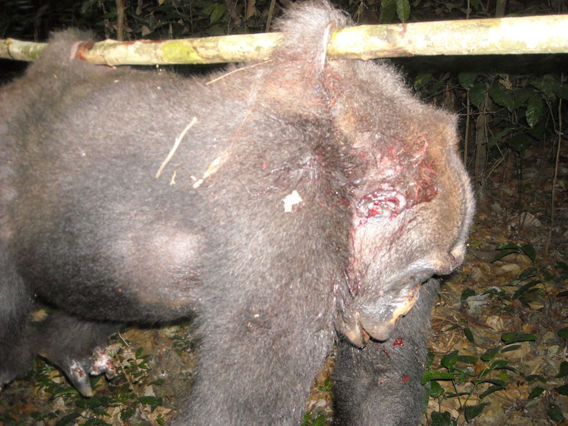
Gorillas are killed for their meat as well as body parts (head and hands) which are sold for fetishes or trophies. To see more photos of bushmeat. Photo courtesy of ESI.
Mongabay: You have been monitoring the trade in bushmeat in Pointe-Noire for several years. What have you found?
Franck Makoundi: Since 2008, Endangered Species International (ESI)-Congo has conducted more than 140 surveys at the seven major markets in the city of Pointe-Noire, which represents around 1,000 bushmeat observations. A third of the observed species are protected under the Republic of the Congo, which illustrates the importance of strengthening the collaboration between the different actors (governments, NGOs, civil society, etc.) in order to raise awareness about the importance of biodiversity and to respect the existing laws on endangered species protection.
Mongabay: What are the animals most commonly seen in the markets?
Franck Makoundi: Over forty different species were identified during our surveys: antelopes (duikers), primates (monkeys and gorillas), reptiles (snakes, crocodiles, freshwater turtles, lizards), rodents (porcupines, cane rats), and forest buffalo.
The eight species that represent 50 percent of the observations on the markets in 2011 were: blue duiker (Cephalophus monticola), white-bellied duiker (Cephalophus leucogaster), African porcupine (Athrurus africanus), forest hinge-back tortoise (Kinixys erosa), African rock python (Python sebae), African slender-snouted crocodile (Crocodylus cataphractus), water chevrotain (Hyemoschus aquaticus) and mandrill (Mandrillus sphinx). Half of these species have protected status.
Mongabay: How many gorillas were identified on the bushmeat markets, and at what price?
.568.jpg)
Makoundi in a market with a blue duiker. Photo courtesy of ESI.
Franck Makoundi: In 2011, gorilla meat was identified seven times in the markets. This figure does not reflect the reality of the illegal trade because meat is also traded through other channels like direct sales to restaurants or individuals. Further, vendors are worried about our surveys and some of them tend to hide gorilla meat. Gorilla is usually sold as smoked meat. A piece of the size of a hand usually costs about 3,000 FCFA ($5.62) and a 50 kilogram bag (110 pounds) is sold for around 35,000 FCFA ($65.15). The head and hands are often subject to parallel trade for fetishism and trophies.
Unlike more common species, the gorilla meat is generally sold to merchants of Pointe-Noire, after being smoked in villages. This can be explained by the high price of this meat. A small portion of the meat is consumed by the hunter and some people around him, including men who are helping to cut down and transport the animal. Women generally do not eat gorilla.
Mongabay: Now that you have this data, what are your conservation plans?
Franck Makoundi: We are launching a project in a forested area, about 150 miles northeast of Pointe-Noire. This area is an ecological corridor between Conkouati-Douli National Park and the Dimonika Biosphere Reserve. The first step is to refine our knowledge on the status of large mammals, particularly the gorilla. Surveys will begin this month. We will also support local hunters in setting up sustainable hunting and alternative economic activities. Data collection will help us create monitoring for remaining gorillas and conduct patrols.
Mongabay: How will you convince the hunters to save the gorillas?
Franck Makoundi: We believe that conservation of biodiversity can not be sustainable without the involvement of local people including hunters. They must therefore be informed of their rights and responsibilities and aware of biodiversity issues. The collective awareness is an essential step for the community to take the lead in protecting its natural environment and its biodiversity, and to establish protective measures respected by all. But it is important to go beyond, by offering support to change economic activities harmful to endangered species while maintaining the same incomes. Most hunters are in this trade to support their families. Thus, it is possible to offer them a support to develop other activities via the establishment of a cooperative.
Mongabay: What is a hunter cooperative?
Franck Makoundi: The hunter cooperative is based on rational hunting and a total hunting ban on endangered and protected species like gorillas. The cooperative will delineate hunting area, hunting calendar, and identify alternative economic activities to be developed. ESI Congo will guide the creation of the cooperative and support its actions. The hunters will be gathering conservation data during hunting activities and will become gorilla protectors by conducting some monitoring as well.
Mongabay: Could you tell us about your education actions?
Franck Makoundi: The issue of endangered species awareness is critical, especially in the Congo Rainforest since it is home to endemic and rare biodiversity (the Congo Basin forest is the second largest rainforest after the Amazon). Biodiversity is severely threatened by logging, mining and hunting. Yet, new generations are poorly informed about environmental issues. Therefore, since the creation of ESI Congo our team has conducted educational activities in schools of Pointe-Noire to explain the importance of preserving biodiversity and the great apes. Our team will continue these actions in the Loaka village where gorillas are hunted by using several media such as animated presentations, movies, games, and field activities in the forest. We have a plan to set up new team activities between classes of Loaka and Pointe-Noire, in order to create another link between the place of hunting and consumption.
Mongabay: How can people help?
Franck Makoundi: It is crucial issue and the urgency is high. The main obstacle for those involved in conservation in the Republic of the Congo lies in the lack of funding. Any support is welcome! You can contact our team to learn more on how to support.
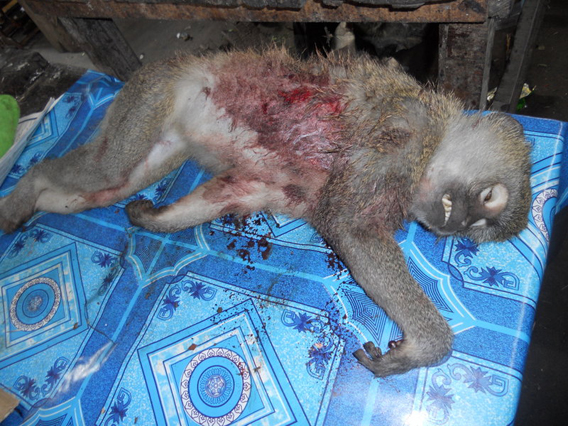
Monkey killed for bushmeat. To see more photos of bushmeat. Photo courtesy of ESI.
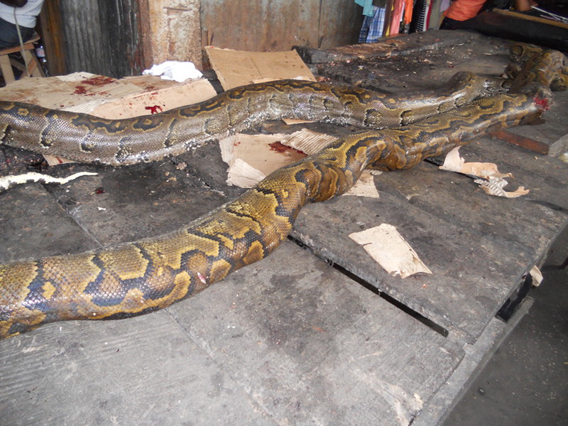
African rock pythons killed for bushmeat. Photo courtesy of ESI.
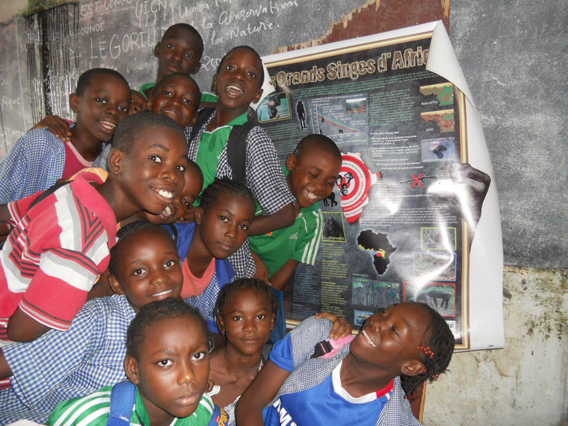
Local students after a presentation on gorillas by ESI. Photo courtesy of ESI.
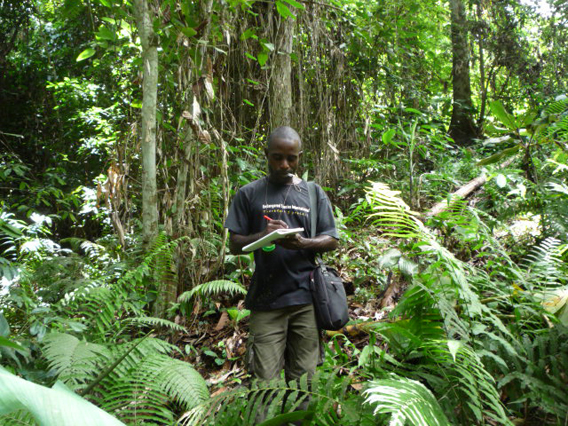
Taking down data in the field. Photo courtesy of ESI.
View Larger Map
Related articles
Over 80 percent of urban Congolese eat bushmeat
(06/27/2011) Bushmeat is one of the major threats to wildlife in parts of Africa: large and medium-sized animals are vanishing from regions in a trend dubbed by biologists the ’empty forest syndrome’. A number of popularly consumed species are also threatened with global extinction. A new study in mongabay.com’s open access journal Tropical Conservation Science surveyed 1,050 households in Brazzaville, the capital of Republic of the Congo, regarding their consumption of bushmeat only to find that the practice was practically universal: 88.3 percent of households in Brazzaville consumed bushmeat.
Republic of the Congo expands park to protect fearless chimps
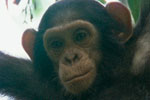
(02/16/2012) The Republic of the Congo has expanded its Nouabalé-Ndoki National Park by 37,295 hectares (144 square miles) to include a dense swamp forest, home to a population of chimpanzees (Pan troglodytes) that show no fear of humans. Known as the Goualougo Triangle, the swamp forest is also home to forest elephants (Loxodonta cyclotis) and western lowland gorillas (Gorilla gorilla gorilla). The expansion of the park to include the Goualougo Triangle makes good on a government commitment from 2001.
First camera trap video of world’s rarest gorilla includes shocking charge
(05/08/2012) Ever wonder what it would be like to be charged by a male gorilla? A new video (below) released by the Wildlife Conservation Society (WCS), gives one a first hand look. Shot in Cameroon’s Kagwene Gorilla Sanctuary, the video is the first camera trap footage of the incredibly rare Cross River gorilla subspecies (Gorilla gorilla diehli); listed as Critically Endangered, the subspecies is believed to be down to only 250 individuals.
Oil exploration approved in Africa’s oldest park, Virunga National Park
(03/19/2012) Permits for controversial oil exploration in Virunga National Park have been released after request by NGO Global Witness. Oil company, SOCO International, has confirmed it has received two permits to undertake preliminary exploration, including seismic tests, in the UNESCO World Heritage Site. Located in the Democratic Republic of Congo (DRC), Virunga is famous for its population of the Critically Endangered mountain gorillas (Gorilla beringei beringei).
Without data, fate of great apes unknown
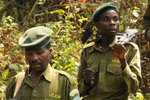
(03/12/2012) Our closest nonhuman relatives, the great apes, are in mortal danger. Every one of the six great ape species is endangered, and without more effective conservation measures, they may be extinct in the wild within a human generation. The four African great ape species (bonobos, chimpanzees and two species of gorilla) inhabit a broad swath of land across the middle of Africa, and two species of orangutans live in rainforests on the islands of Borneo and Sumatra in Southeast Asia.
10,000 sq mi of Congo rainforest declared World Heritage site
(07/02/2012) Central Africa has the newest World Heritage site.
Elephant numbers halved in Central Africa in 5 years
(06/08/2012) Elephant numbers in areas surveyed by the Wildlife Conservation Society (WCS) in Central Africa halved between 2006 and 2011, hinting at the carnage wrought by the surging commercial ivory trade and demonstrating a need to boost protection efforts, said the Bronx Zoo-based conservation group.
Financial crisis pummels wildlife and people in the Congo rainforest
(09/27/2010) Spreading over three central African nations—Cameroon, Central African Republic, and Republic of Congo—the Sangha tri-national landscape is home to a variety of actors: over 150,000 Bantu people and nearly 20,000 pygmies; endangered species including forest elephants and gorillas; and, not least, the Congo rainforest ecosystem itself, which here remains largely intact. Given its interplay of species-richness, primary rainforest, and people—many of whom are among the poorest in the world—the landscape became internationally important in 2002 when under the Congo Basin Forest Partnership (CBFP) conservation groups and development agencies agreed to work together to preserve the ecosystems while providing development in the region.